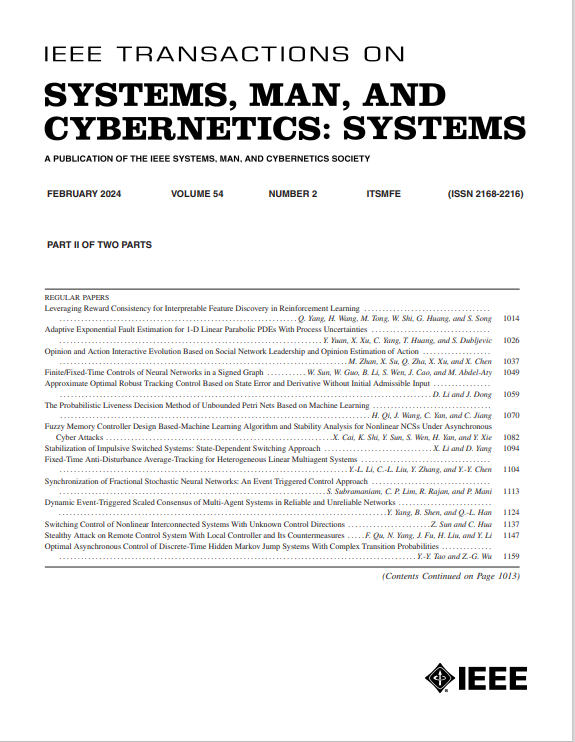Twin Trust Region Policy Optimization
IF 8.6
1区 计算机科学
Q1 AUTOMATION & CONTROL SYSTEMS
IEEE Transactions on Systems Man Cybernetics-Systems
Pub Date : 2025-06-10
DOI:10.1109/TSMC.2025.3573513
引用次数: 0
Abstract
Trust region policy optimization (TRPO) is an iterative reinforcement learning algorithm that both maximizes a surrogate objective based on a generalized advantage function and enforces a trust region constraint between two consecutive policies based on the Kullback-Leibler divergence in each iteration. On the one hand, its surrogate objective only approximates the positive theoretical improvement and thus relaxes the theoretical guarantee. One the other hand, currently, TRPO is approximately solved via a linear approximation for its objective and a quadratic approximation for its constraint, which results in an upper bound for the linear search of the step size. However, this solution strategy does not provide a lower bound for the step size search. Intuitively, a lower bound could be determined manually, but such a setting has no physical meaning. To this end, we present an alternative solution in this article, which is to exchange the objective and the constraint in TRPO according to reciprocal optimization technique, and then derive a reciprocal TRPO. Applying a similar approximation solution of TRPO to our reciprocal TRPO produces a lower bound for the step size search that has a physical interpretation for improving the surrogate objective or return. Further, we aggregate the original TRPO with this reciprocal TRPO to construct a twin TRPO, whose step size has a lower bound from our reciprocal TRPO and an upper bound from TRPO, to facilitate the policy optimization and achieve a least return improvement. Extensive experiments on twelve benchmark environments show that our twin TRPO is superior to six existing techniques: the original TRPO, proximal policy optimization, off-policy TRPO and two entropy regularized TRPOs, as well as our reciprocal TRPO. Our code is available at双信任域策略优化
信赖域策略优化(Trust region policy optimization, TRPO)是一种迭代强化学习算法,它既基于广义优势函数最大化代理目标,又在每次迭代中基于Kullback-Leibler散度在两个连续策略之间施加信赖域约束。一方面,它的替代目标只近似于积极的理论改进,从而放松了理论保证。另一方面,目前的TRPO是通过目标的线性逼近和约束的二次逼近来近似求解的,这导致了步长线性搜索的上界。然而,这种解决策略并没有为步长搜索提供一个下界。直觉上,下限可以手动确定,但这样的设置没有物理意义。为此,本文提出了一种替代方案,即根据互反优化技术将TRPO中的目标和约束交换,从而推导出一个互反TRPO。将TRPO的类似近似解应用于我们的互反TRPO,会产生步长搜索的下界,这对于改善代理目标或回报具有物理解释。进一步,我们将原TRPO与该互反TRPO聚合,构建了一个双TRPO,其步长下界为我们的互反TRPO,上界为TRPO,以促进策略优化,实现最小收益改进。在12个基准环境下的大量实验表明,我们的孪生TRPO优于现有的六种技术:原始TRPO、近端策略优化、非策略TRPO和两熵正则化TRPO,以及我们的互反TRPO。我们的代码可在https://github.com/HTXu-UTS/twinTRPO上获得。
本文章由计算机程序翻译,如有差异,请以英文原文为准。
求助全文
约1分钟内获得全文
求助全文
来源期刊

IEEE Transactions on Systems Man Cybernetics-Systems
AUTOMATION & CONTROL SYSTEMS-COMPUTER SCIENCE, CYBERNETICS
CiteScore
18.50
自引率
11.50%
发文量
812
审稿时长
6 months
期刊介绍:
The IEEE Transactions on Systems, Man, and Cybernetics: Systems encompasses the fields of systems engineering, covering issue formulation, analysis, and modeling throughout the systems engineering lifecycle phases. It addresses decision-making, issue interpretation, systems management, processes, and various methods such as optimization, modeling, and simulation in the development and deployment of large systems.
 求助内容:
求助内容: 应助结果提醒方式:
应助结果提醒方式:


